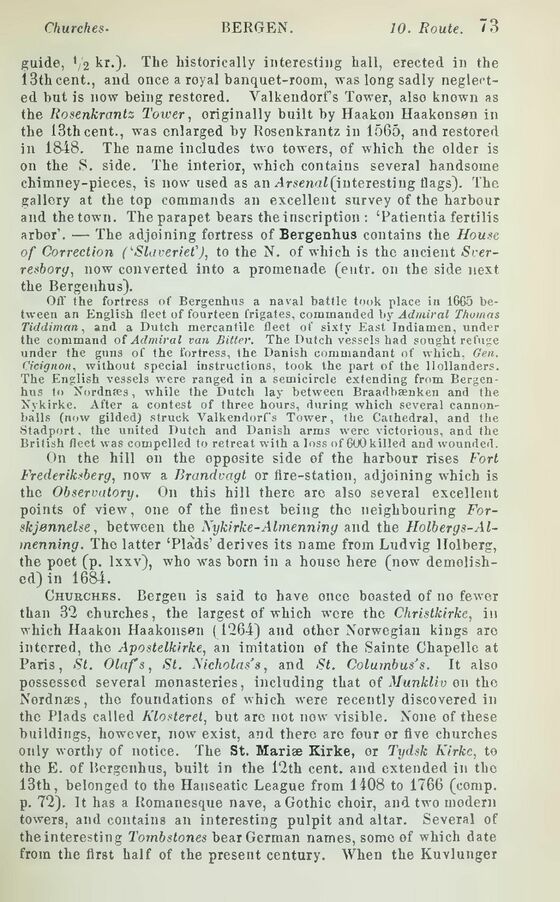
Full resolution (JPEG) - On this page / på denna sida - Norway - Pages ...

<< prev. page << föreg. sida << >> nästa sida >> next page >>
Below is the raw OCR text
from the above scanned image.
Do you see an error? Proofread the page now!
Här nedan syns maskintolkade texten från faksimilbilden ovan.
Ser du något fel? Korrekturläs sidan nu!
This page has never been proofread. / Denna sida har aldrig korrekturlästs.
guide, */2 kr.). The historically interesting hall, erected in the
13th cent., and once a royal banquet-room, was long sadly
neglected but is now being restored. Valkendorf s Tower, also known as
the Rosenkrantz Tower, originally built by Haakon Haakonson in
the 13th cent., was enlarged by Rosenkrantz in 1565, and restored
in 1848. The name includes two towers, of which the older is
on the 8. side. The interior, which contains several handsome
chimney-pieces, is now used as an vlrsenal(interesting flags). The
gallery at the top commands an excellent survey of the harbour
and thetown. The parapet bears the inscription : ‘Patientia fertilis
arbor’. — The adjoining fortress of Bergenhus contains the House
of Correction (’Slaveriet’), to the N. of which is the ancient
Sver-resborg, now converted into a promenade (entr. on the side next
the Bergeuhus).
Off the fortress of Bergenhus a naval battle took place in 1665
between an English fleet of fourteen frigates, commanded by Admiral Thomas
Tiddiman, and a Dutch mercantile fleet of sixty East Indiamen, under
the command of Admiral van Bitter. The Dutch vessels had sought refuge
under the guns of the fortress, the Danish commandant of which, Gen.
Cicignon, without special instructions, took the part of the Hollanders.
The English vessels were ranged in a semicircle extending from
Bergenhus to Nordnæs, while the Dutch lay between Braadhænken and the
Nykirke. After a contest of three hours, during which several
cannonballs (now gilded) struck Valkendorfs Tower, the Cathedral, and the
Stadport, the united Dutch and Danish arms were victorious, and the
British fleet was compelled to retreat with a loss of 6U0killed and wounded.
On the hill on the opposite side of the harbour rises Fort
Frederiksberg, now a Brandvagt or fire-station, adjoining which is
the Observatory. On this hill there are also several excellent
points of view, one of the finest being the neighbouring
Forskjønnelse, between the Nykirke-Almenning and the
Holbergs-Al-menning. The latter ‘Plads’ derives its name from Ludvig Holberg,
the poet (p. lxxv), who was bom in a house here (now
demolished) in 1684.
Churches. Bergen is said to have once boasted of no fewer
than 32 churches, the largest of which were the Christkirke. in
which Haakon Haakonsen (1264) and other Norwegian kings are
interred, the Apostelkirke, an imitation of the Sainte Chapelle at
Paris, St. Olafs, St. Nicholas’s, and St. Columbus’s. It also
possessed several monasteries, including that of Munkliv on the
Nordnæs, the foundations of which were recently discovered in
the Plads called Klosteret, but are not now visible. None of these
buildings, however, now exist, and there are four or five churches
only worthy of notice. The St. Mariæ Kirke, or Tydsk Kirkc, to
the E. of Bergenhus, built in the 12th cent, and extended in the
13th, belonged to the Hanseatic League from 1408 to 1766 (comp,
p. 72). It has a Romanesque nave, a Gothic choir, and two modern
towers, and contains an interesting pulpit and altar. Several of
theinteresting Tombstones bear German names, some of which date
from the first half of the present century. When the Kuvlunger
<< prev. page << föreg. sida << >> nästa sida >> next page >>